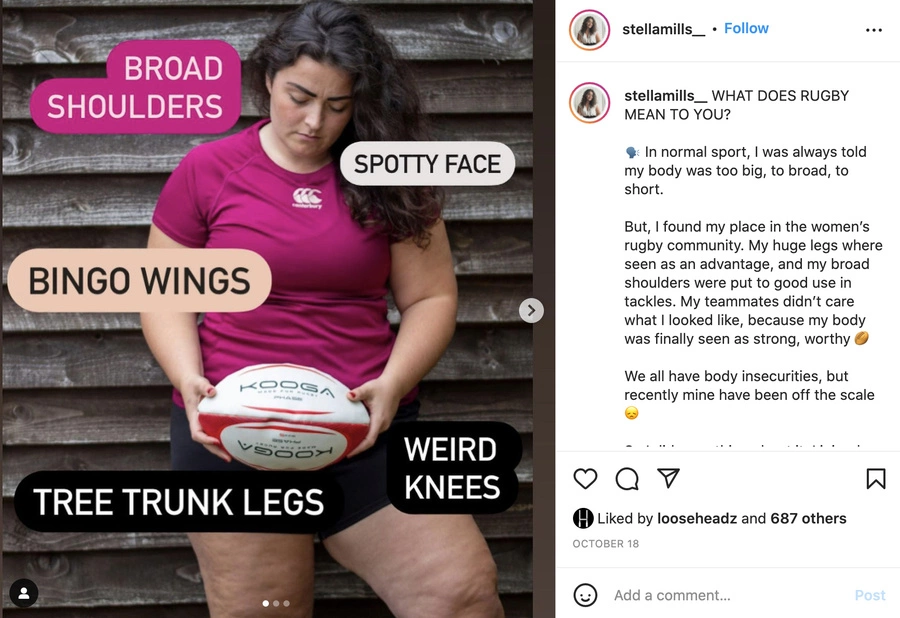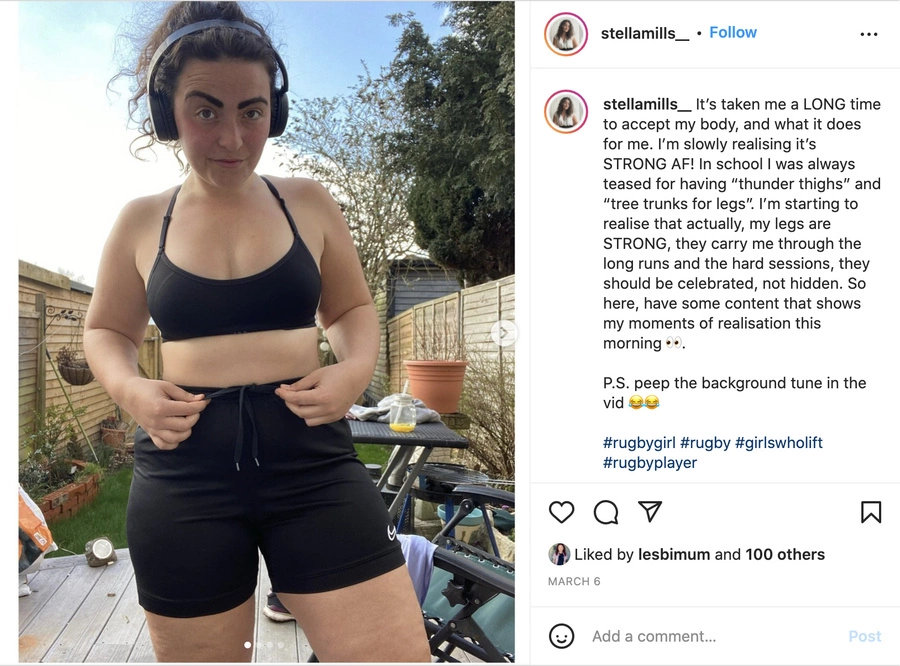
Rugby's Body Acceptance Movement
I am not body positive; and here’s why.
After posting the below image on social media, I received various messages praising me for my ‘body positivity’, even family members remarked that they ‘liked my body positivity stuff ’. For some reason, those comments didn’t sit well with me, but I didn’t understand why.
After a bit of reflecting, I realised my gripe with the phrase stems from the associations that come with it. The phrase itself suggests we should be positive all the time, and constantly love our bodies when in real life that’s far from the case. Why can’t I just accept my body for what it is, and what it does for me, instead of constantly being ecstatic about it online?
For example, within this movement, we see normal things being glorified all over social media, to fit into the wider, I would argue almost toxic, narrative of body positivity. Take stretchmarks, why do I have to pour glitter over myself and call them “tiger stripes” in order for them to be deemed socially acceptable? Why can’t they just be recognized as part of my body, instead of being beautified for the benefit of followers?
You don’t have to love your body every single day, you just have to accept it for what it is.
Body neutrality provides a more realistic mindset, the movement explains that we won’t ‘love’ our bodies every single day because that’s an unrealistic expectation. Instead, it encourages individuals to accept their bodies for what they are and reframe them for what they do, instead of how they look, which is exactly where women’s rugby comes into play.
The attributes that are viewed in normal society as flaws such as having big legs, wide shoulders and muscular arms are seen as positives on a rugby pitch. My big legs give me the power to drive me forward in the scrum, my wide shoulders allow me to hit tackles hard and my muscular arms provide me with the strength to wrap and hold in a tackle.
This isn’t just about me and what I feel, Girls Rugby Club recently conducted research that found an overwhelming 90% of young girls who were surveyed found their self-esteem and confidence increased whilst playing rugby.
With a rise of young girls taking up the sport, we have a chance to move away from the narrative that the way you look defines your worth, and rugby could be the tool to help with this.
As a child I was often teased by boys in my year because my legs looked different to other girls. They were a lot bigger, which at the time I believed was a negative. I would always hide my legs and make excuses not to participate in P.E. lessons for fear of having to wear shorts. Until I found rugby.
Rugby gave me the confidence to understand my body was strong. My peer’s opinions of me changed almost overnight when I took the sport up. It was like something switched in my head, and I started see my body in a whole new light.
That being said, I am thankful that I grew up when I did. Focus on body image has never been so high with the pressure on young girls to look perfect across social media. We now live in a filtered society, where young girls and boys are encouraged to edit themselves to fit into perceived beauty norms. Playing into this can be extremely damaging for your mental health. Don’t get me wrong, I know this is nothing new as photoshopped front covers have been around for years, but with the accessibility of social media, it has now become all consuming.
To kickstart real change, we need to see more representation on our screens of real-life bodies and that starts with female rugby players. Rugby as a sport is well known for its inclusivity, there really is room for everyBODY on the pitch. It doesn’t matter what you look like at training, it matters what you bring to the table skill wise. The Autumn Nations matches being broadcast on mainstream TV is certainly a welcomed move forward, as the phrase goes ‘Can’t see it can’t be it’. We are giving young girls the opportunity to look to the TV and see a body that is just like theirs, doing something extraordinary, which can only be a good thing in my opinion.
Added to this, we are also starting to see a significant shift from clothing companies to make clothing specifically for female bodies, which is welcomed. Ruggette RFC, for example, manufacture rugby kit for women, made by women. Small changes to things like waistbands and inseams can make all the difference to allowing women to feel more comfortable going along to training sessions, which can only help, right?
To sum up, I want to move past the body positive movement, and onto normalization of our bodies. I want people to know and understand that it’s okay not to be fully happy in your own skin, in fact its normal to feel like this at times. What’s not okay, however, is to be pressured into looking a certain way, and fitting into a certain mould in order to be deemed ‘beautiful’ in society. We need to be teaching those that come after us that how they look isn’t as important as how the feel.
Rugby can play a huge part in the normalization of our bodies, and that is why rugby simply means more.


